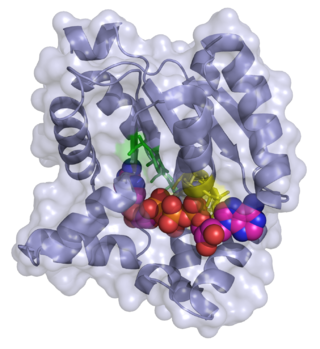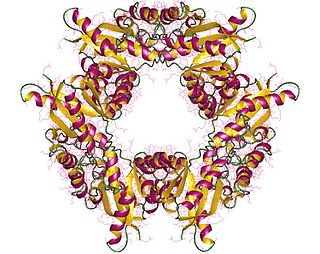 | |
| Names | |
|---|---|
| Systematic IUPAC name (22R,23R,24S,25R)-16,134-Diamino-23,24,5,7,9-pentahydroxy-134,152-dimethyl-5,7,9-trioxo-4,6,8,10-tetraoxa-5λ5,7λ5,9λ5-triphospha-133λ5-1(9)-purina-15(5)-pyrimidina-13(5,3)-[1,3]thiazola-2(2,5)-oxolanapentadecaphan-133-ylium | |
| Other names P1,P3-(Adenosine-5′-thiamine) triphosphate | |
| Identifiers | |
| |
3D model (JSmol) | |
| ChEBI | |
| ChemSpider | |
| MeSH | adenosine+thiamine+triphosphate |
PubChem CID | |
| UNII | |
CompTox Dashboard (EPA) | |
| |
| |
| Properties | |
| C22H31N9O13P3S | |
| Molar mass | 754.52 g·mol−1 |
Except where otherwise noted, data are given for materials in their standard state (at 25 °C [77 °F], 100 kPa). | |
Adenosine thiamine triphosphate (AThTP), or thiaminylated adenosine triphosphate, is a natural thiamine adenine nucleotide. [1] It was discovered in Escherichia coli where it may account for up to 15 - 20% of total thiamine under carbon starvation. AThTP also exists in eukaryotic organisms such as yeast, roots of higher plants and animal tissues, albeit at a much lower concentration. It was found to exist in small amounts in the muscle, heart, brain, kidneys and liver of mice. [2]
Contents
In E. coli AThTP is synthesized from thiamine diphosphate (ThDP) according to the following reaction catalyzed by thiamine diphosphate adenylyl transferase: [3]
- ThDP + ATP (ADP) ↔ AThTP + PPi (Pi)













